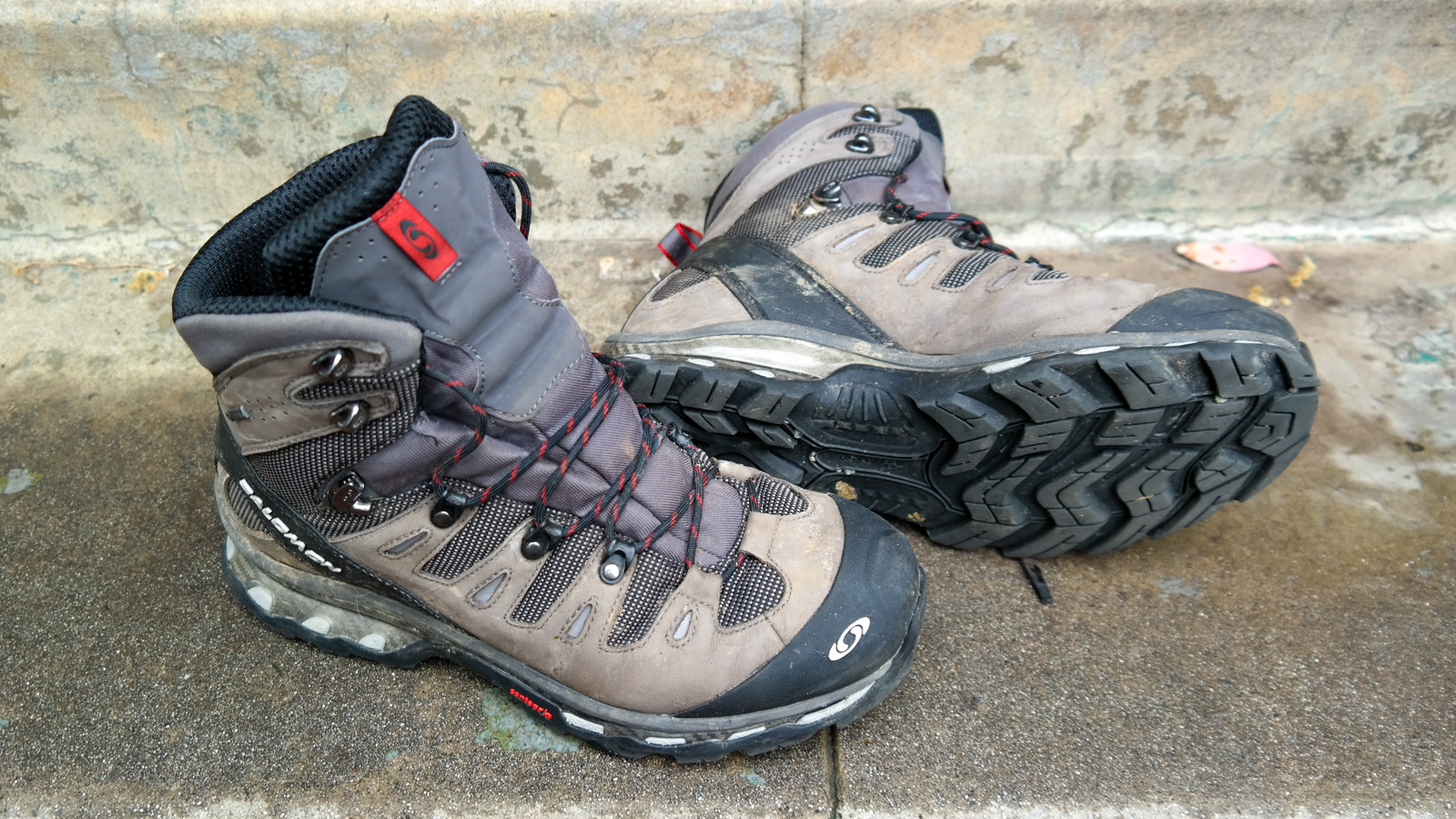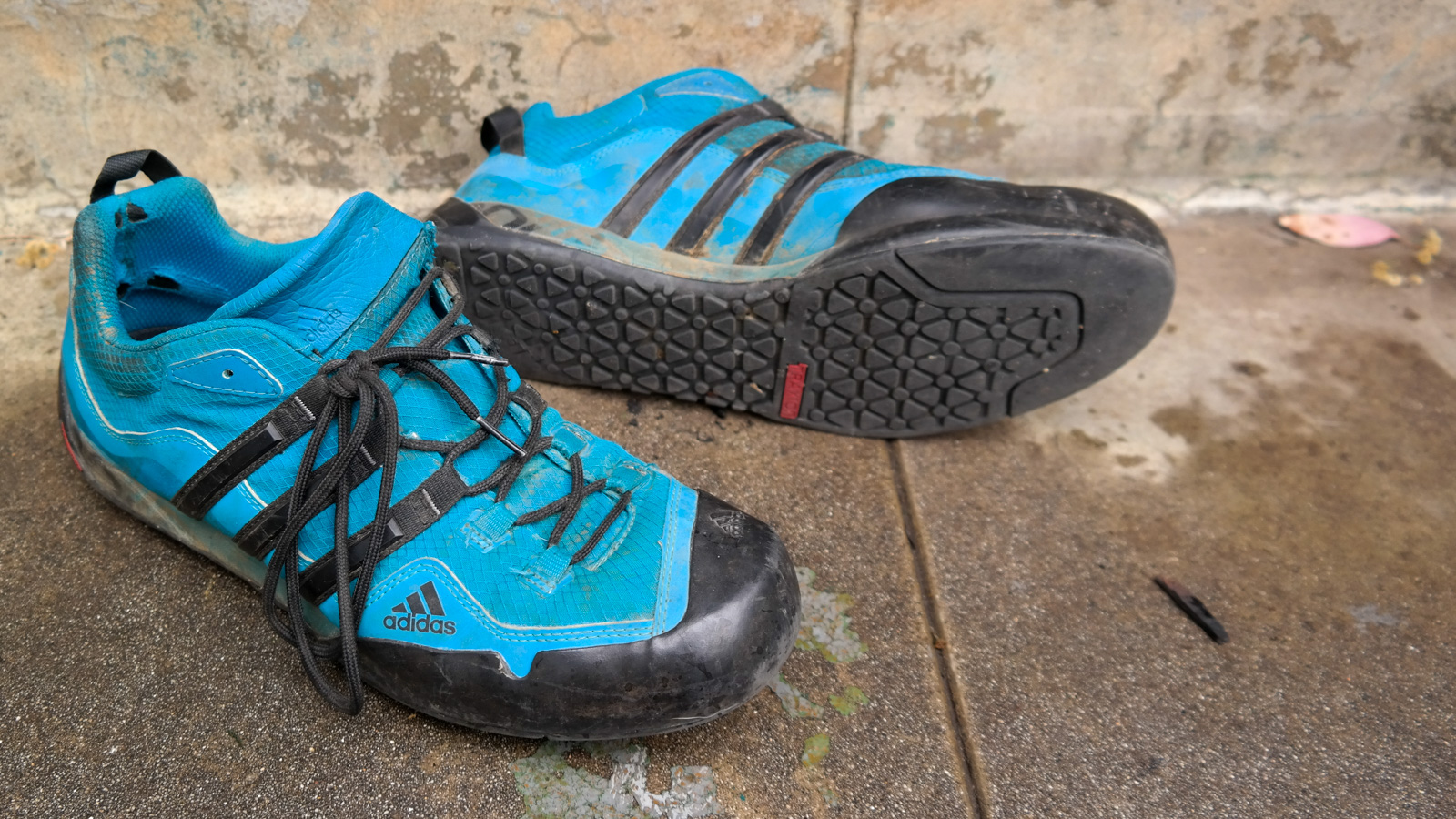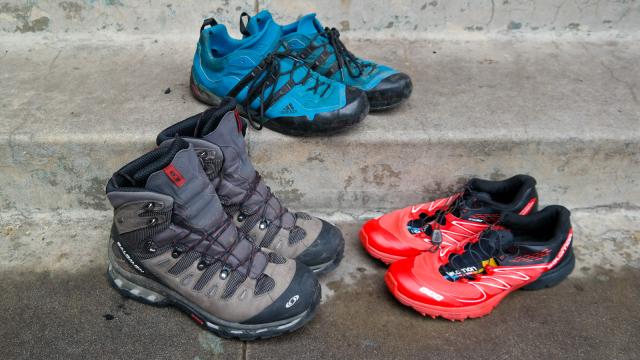You want to wear hiking boots to go hiking, right? That may be conventional outdoors wisdom, but often, it’s not the right answer. Let’s examine the merits of each and try to help you find the right solution.
Each of us has our own individual needs for footwear. A lot of which shoe or boot is right for you depends on how strong and flexible your ankles are, how much weight you plan on carrying, the size and shape of your feet and the terrain you plan to cross, as well as just your preferences and what you feel most comfortable in.

Hiking Boots
These are top-of-the-range Salomon Quest 4D GTXs ($US230) that I’ve worn on Wiley and I’s daily hike a few times to break them in, then took them to the Lost Coast. I’m kind of cheating here, because at 650 grams, these are about as light as a heavy duty backpacking boot gets. But they still give you all the torsional stiffness, ankle support, heavily lugged sole and waterproofness that you’d expect from something heavier.
Pros:
- Waterproof membrane keeps boot dry even when submersed to ankle height.
- Thick, strong sole protects your foot from uneven terrain while providing secure footing.
- Pronounced sole lugs provide excellent traction in mud or through other slippery surfaces.
- Maximizes protection from terrain, brush and in falls.
- Allows you to hike off-piste with impunity.
- Excellent ankle support for heavy loads.
- Made to accept orthopedic insoles.
- Longevity.
- Snakes.
Cons:
- Retains water if soaked and takes multiple days to dry completely.
- Considerably heavier than shoes.
- Difficult to run in.
- Expensive.
- Require break-in periods.
- Little to no ventilation can equal sweaty feet.

Trail Runners
These are Chris’s super fancy Salomon S-Lab Ultras ($US120). The basic idea with using trail runners for hiking is that they combine decent torsional rigidity in their soles and excellent grip with very light weights. These weigh only 240 grams. There’s an old saying in backpacking circles, “A pound on your feet is equivalent to five on your back.”
Pros:
- Contributes far less to fatigue on long days.
- Enables you to move as fast as possible.
- Excellent traction on moderate terrain.
- Drains and dries quickly.
- Little to no break-in period required.
- Breathes and vents extraordinarily well.
- You don’t need more support if you’re carrying less than 25 lbs.
Cons:
- Little to no traction on wet rocks or through mud.
- Relatively easy to stub a toe.
- Debris can easily enter shoe.
- No ankle support.
- Not waterproof or, if fitted with a membrane, still not waterproof.
- Doesn’t smash through underbrush like a boot.
- Wears out quickly.
- Leaves ankles exposed to thorns, poison oak, rocks and falls.
- Snakes.

Approach Shoes
Sort of a hybrid between a climbing shoe and a trail runner, approach shoes are great for rock scrambling and crossing varied terrain on your way to a climb. Carrying a bunch of injuries from motorcycles, I’m not a huge climber, but these Adidas Outdoor Terrex Swift Solos ($US100) are perfect for the hikes I do in Southern California that frequently involve a little light bouldering. Like a climbing shoe, the sole wraps up and over your toe and the toe box strongly resists twisting or folding to facilitate good edging. Unlike a running shoe, there’s less drop (to optimise them for walking), but they’re built similarly light and well ventilated. These weigh 312 grams.
Pros:
- Surprisingly good toe protection. I put a huge hole through a brand new GTI’s front bumper after it nearly hit Wiley in a crosswalk without hurting my toes at all.
- Extraordinarily good traction over slippery wet rocks. I wore these to hike to that waterfall in Hana, travelling a mile upstream through mild rapids and they provided sure footing throughout.
- Strong soles provide good protection from terrain.
- Reasonably light weight.
- Excellent ventilation.
- Great for scrambling on and around rocks.
- Extraordinary traction over loose surfaces, such as those found in SoCal.
- Can be laced super tight, like a proper climbing shoe.
- Drain and dry quickly.
Cons:
- Poor heel retention.
- Somewhat cramped toe box.
- Not waterproof and, even with a membrane, they will allow water in.
- No grip in mud.
- Allows debris to enter way too easily.
- Not optimised for running (if you occasionally want to use them for such).
- Wears out quickly, although not as bad as trail runners.
- Snakes.
My own personal solution ends up being a mix between boots and shoes. On that Lost Coast trip, I was the only one wearing boots, while Matt and Ty both wore trail runners. I had an easier time on steep descents, but they had a noticeable advantage on long, challenging uphill sections. In the numerous water crossings, I had more secure footing, but their shoes dried quickly while I was stuck with wet feet for almost the entire trip.
What are your best solutions for what shoes to wear on a hike?
